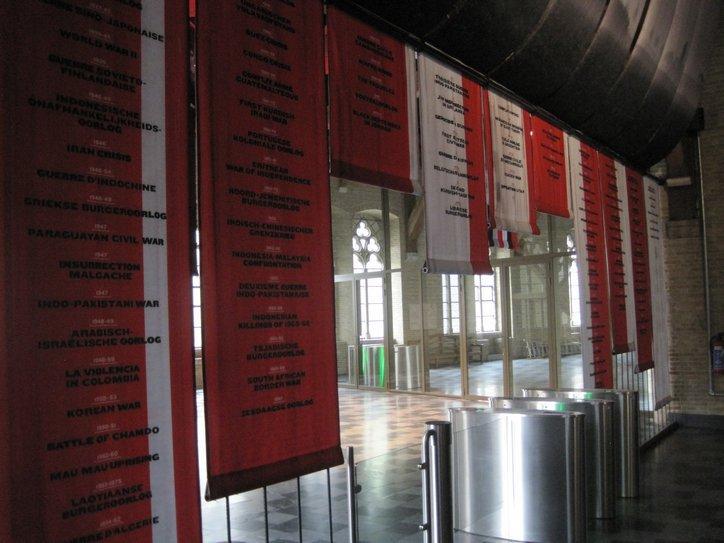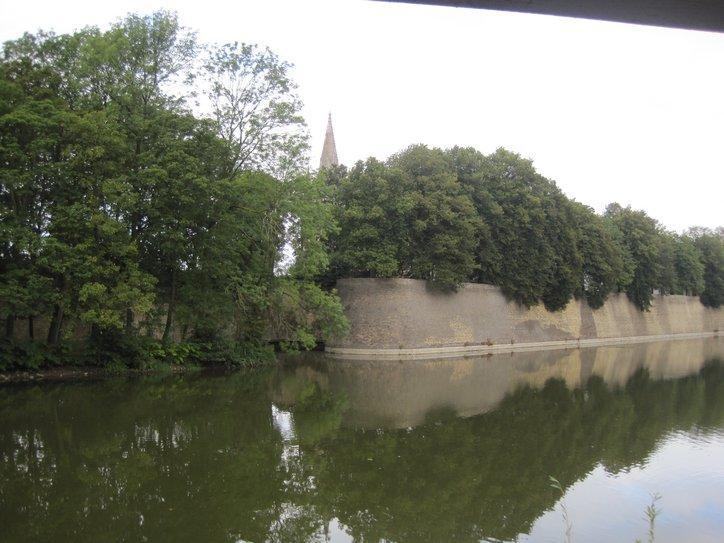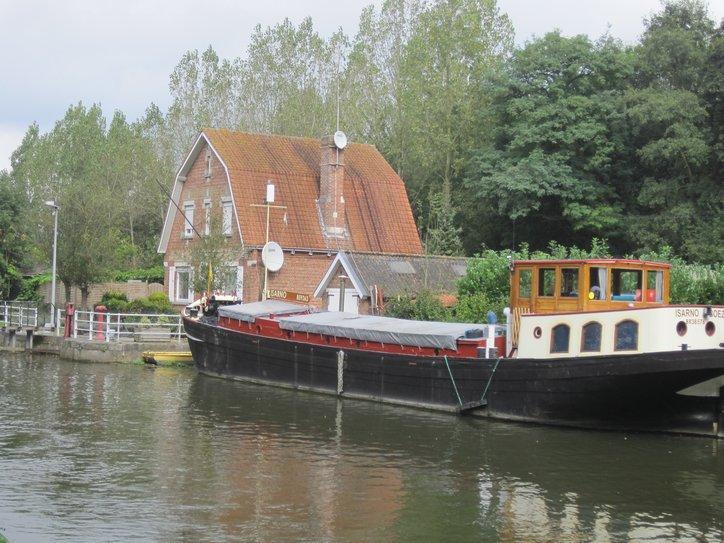September 17, 2012
Day 121: Ieper , Belgium to Bray-Dunes, France
The In Flanders Fields Museum
Yesterday when I wrote that I only thought there was a Rathuis in the market square, it was because the huge building that occupies most of the space was in a gothic style and looked most like a church. There is a church, but the huge building reflects the former guild system, and is the Rathuis. The museum is in this building, and this pride of place is not only justified by its tremendous quality, but also by the peace orientation of the museum and the entire city.
As we saw at the Menen Gate last night, a large number of people remain interested in the subject of the World Wars. Not having spoken to them (with one exception – just leaned over and asked the guy at the next table at this restaurant – see that report below Harry and William) it’s hard to say why they were there, or why they are in the museum. I think the reasons are of course varied, but probably the main one is simply the huge nature of the event. People, including us, will flock to Graceland, so why not flock here. Beyond that, there are the interesting specifics of the thing: the political economy, the sociology, the military history, the geography. Others, like us, still have knowledge of relatives who were involved, or who are looking for graves of grandfathers. Finally there is the peace movement or motive, and the feeling that these historical events must be remembered to avoid such mistakes in future. Anyway, this museum is extremely popular. At the ticket area they were preparing bags of entry bracelets, each bag for a group. There were piles of bags.
THE MUSEUM
On this trip we have not visited a lot of museums, both because of reluctance to leave the bikes and because of a continual drive to keep pedalling. So we are not museum experts, but anyone can see how innovative and effective this one is.
They start you off with a magnetic bracelet. Readers throughout the museum recognize you, and can customize your experience, in terms of the information that comes up on display screens. The display screens are beside cases containing artefacts. If you want to know more about something, you can call up the information. Otherwise, they do not bother you with it. Finally, they can email or print some kind of summary of your visit, based on what you looked at and asked for. We did not really take advantage of this system, but it looked like it had a lot of potential.
Walking through the museum overall was much like walking through a giant, well written coffee table book. The graphics are great, and the text is thoughtful and feels complete, without being pedantic. In this case, though, the book includes displays of real objects, video of actors portraying soldiers in various circumstances – each with a moving monologue, vintage photos and video, table top models, etc.
There is sound in the building too, but rather than perhaps sound effects of guns or suchlike, it is just rather eerie mood music. We found it effective.
The museum sets the scene by starting with a display about La Belle Époque – the optimistic time in the late 1800’s. It then continues, describing the empire building and alliance making that went on. The quest for power and influence, the control of the state over education and public opinion, and generally what later we call the military-industrial complex are cited as the cause of the war. There is no specific reference to the grand duke’s assassination, often given as the cause in simplistic accounts.
The displays go on to describe the fields of battle – where they were, what they were like, the destruction in cities, the flows of refugees, the armaments, the strategies, the loss of life figures, etc. etc. One interesting thing was the Belgian perspective that was part of many of the descriptions. What the Belgian army did and how Belgium was affected received a lot of attention. Since we are in Belgium, this is normal, but it still was notable since the Belgian point of view is often overlooked – they were just the ground over which much of the battle was fought.
We were blown away to find the central role of the Ijzer River in the whole thing. There were displays showing the whole Ijzer area, and showing how portions had been flooded purposely by breaching the dike, to create a no man’s land. Critically, the towns we had passed through yesterday, and the very cycle path we used, were all key in the story. As usual, we had gone to these towns just by accident.
In terms of perspective, the museum also brought a tone that did not glorify war, nor praise the participants as heroes. It did not denounce them either, but felt different from Remembrance Day stuff back home, which does usually have a heroes and glory flavour.
Finally, at the end of the display, the museum brings forward a peace theme. Leaving the rooms, the visitors pass under banners listing the numerous wars that have followed the war to end all wars. Then there is a display about Mayors for Peace, listing hundreds of participating towns worldwide. We were gratified to see that our “home towns” – Duncan BC and Montreal Quebec are listed.
After WWI Winston Churchill (already in politics) recommended that Ieper be retained in its destroyed state as a monument. This was rejected, and the city was rebuilt. Yet it seems to have adopted a peace orientation nonetheless and refers to itself as the peace city. The museum certainly fits in with this.
Our reaction to the thing was very positive, although the depiction of the horror and suffering was hard to take. The monologues by actors were particularly powerful. Notably they portrayed soldiers from all sides, describing how it was for them in particular circumstances. All displays were also in four languages – Flemish, English, French, and German –the main languages of the combatants, and probably of the visitors.
Finally, the “gift shop”, as would be expected from the overall tone of the museum, was devoid of tourist junk. Mostly it was books. There was also an overlap with tourist information. There were things like books on cycle tours of the battlefield areas. We bought two maps of the point to point cycle system for our route to Dunkirk. At 6 euros each, they were pricey, but this is the only way to navigate by bike in Belgium (maps at the “stations” are weak or non existent).

| Heart | 0 | Comment | 0 | Link |

| Heart | 0 | Comment | 0 | Link |

| Heart | 0 | Comment | 0 | Link |

| Heart | 0 | Comment | 0 | Link |

| Heart | 0 | Comment | 0 | Link |

| Heart | 0 | Comment | 0 | Link |

| Heart | 0 | Comment | 0 | Link |

| Heart | 0 | Comment | 0 | Link |

| Heart | 0 | Comment | 0 | Link |

| Heart | 0 | Comment | 0 | Link |

| Heart | 0 | Comment | 0 | Link |

| Heart | 0 | Comment | 0 | Link |
The emotional impact of the museum can call to mind music that we know that carries a similar impact and message. In the Guestbook, Arthur has mentioned "Tenting on the Old Campground". Look at that here.
We also were thinking in musical terms, and mentioned "Masters of War" by Bob Dylan and "Universal Soldier" by Buffy Saint Marie. One, "Letter to Marie" by Doug McArthur seems very much in tune with the museum.
The Saint Martin and Saint Nicholas Church
Though yesterday I thought city hall here was the church, today we did find the real church, just behind the city hall. This church originated around 1000, but was destroyed in 1914. It was then totally rebuilt, basically following the original design. It must have been a great job, because we found the place to be very impressive and filled with all kinds of treasures, carvings, and the like. By now we are used to beautiful churches, and would class this as just “normal” when compared to all the others, but we still enjoyed seeing it.

| Heart | 0 | Comment | 0 | Link |

| Heart | 0 | Comment | 0 | Link |
Lunch with the RAF
This title is really a total exaggeration. We had chosen a café in the market square for some food before leaving town. We were sitting there reflecting on the museum experience, and as mentioned, I asked the man in the next seat why he had come to this town. He turned out to be an RAF captain who in part was gathering material for a talk to trainees about military history. The five others at his table were also with the RAF. I took the gamble of asking what their reaction was to the museum, and what their own approach would be if asked to go bomb and kill somebody. I found the answers to be very reasoned and thoughtful. It is really not an easy question!

| Heart | 0 | Comment | 0 | Link |
Heading North
We left town by the Menin Gate, noting the words carved in its face “Pro Patria Pro Regem”, meaning “for country and for king”. We thought, in 1920 they still hadn’t learned that that is garbage as a reason to kill and be killed.
We had plotted out a route with the cycling points, and it first took us back along the canal. We quickly came back to the John McRae site, but did not stop since now we had a mission – get close to Dunkirk – a full day’s cycle in ½ day.
Though we wanted to go quickly, we stuck with the cycling point routes which are small and indirect. The bigger roads, though safe with cycle lanes, were just too noisy. On a bigger road for a short time, we noticed some police on the other side. They had two VW vans, always strange since in Canada they are only driven by hippies, retirees, or in our case, retired hippies. There was also a large motorcycle, and at first I thought they had snared this in a speed trap. But the cycle was a police one, so we passed not knowing quite what they were up to.
After we had passed, the cycle fired up and came around abreast of us. The officer first said, “Oh, those are just lights”. Apparently he had mistaken our helmet lights for cameras, and for some reason that triggered him to chase us down. Maybe he thought we were filming his sting operation, or whatever. After that, the conversation became all UQ’s. He admired how far we had come, how we had had no flats, etc. etc. We were somewhat cagey about how many Shengen days we had taken while doing all those kilometres, but I later said to Dodie “Maybe they could throw us in one of those vans and drag us to Dunkirk to see us on a ferry out of here”. “Forget it”, she replied “You are cycling your way to Dunkirk on your own!” The remaining cycling was a bit routine, as we passed through general pastures and corn fields. There were lots of cows to talk to, though, and some exotics like deer and llamas.
Just before we crossed into France, there we rows of tobacco shops. There must be some sort of tax difference between Belgium and France on this. We hopped on a fairly major road, because it was marked as the cycle route to Dunkirk, but in Belgium the cycle way became just a narrow shoulder and in France it disappeared!
About 10 km from Dunkirk we took a turn for what he sign said was municipal camping. We think we ended in the wrong place, because for 18 euros we have a patch of dirt in a trailer slum with a hike to the toilet block and no wifi. The place is called Les Dunes, in Bray-Dunes. Avoid it!

| Heart | 0 | Comment | 0 | Link |

| Heart | 0 | Comment | 0 | Link |

| Heart | 0 | Comment | 0 | Link |

| Heart | 0 | Comment | 0 | Link |

| Heart | 0 | Comment | 0 | Link |

| Heart | 0 | Comment | 0 | Link |
Today's ride: 65 km (40 miles)
Total: 6,446 km (4,003 miles)
| Rate this entry's writing | Heart | 0 |
| Comment on this entry | Comment | 0 |

























